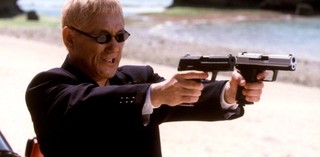APT6 Cinema Takeshi Kitano, Ang Lee, Rithy Panh

Production still from Takeshis' 2005 | Director: Takeshi Kitano | Image courtesy: Celluloid Dreams / View full image
When
5 Dec 2009 – 5 Apr 2010
Where
Gallery of Modern Art, Cinema A
About
Two major projects are presented at the Australian Cinémathèque for APT6: Promised Lands and The Cypress and the Crow: 50 Years of Iranian Animation, which encompass diverse video and filmmaking practices, genres and makers, working across cinema and contemporary art. Three filmmakers are also included among the APT6 artists, and will be profiled with retrospective seasons during the exhibition: Takeshi Kitano (Japan), Ang Lee (Taiwan/USA), Rithy Panh(Cambodia/France).
Australian Cinémathèque programs include films that have not been officially classified in Australia. These films have been assigned age recommendations as a guide only. Parents and teachers are advised to contact the Cinémathèque if they would like more information as to the content and suitability of the films.
Takeshi Kitano
Director, actor, author, comedian, artist and cult television personality, Takeshi Kitano has forged an original and idiosyncratic film practice unique in contemporary cinema. Drawing on genre cinema and Japanese consumer culture, Kitano's yakuza (Japanese mafia) films and self-reflexive comedies blend action cinema with a strong sense of the absurd in contemporary life. Kitano fuses nihilism with humour, violent excess with deadpan characterisation, and uses exaggerated choreographies of movement and dark comedy to punctuate otherwise silent and static sequences. Beginning his career as a comic presenter on Japanese TV, his legendary alter ego, 'Beat Takeshi', is one of the most identifiable pop culture icons in Japan, and Kitano continues to appear on long-running television shows.
Ang Lee
Internationally acclaimed filmmaker Ang Lee has constructed a remarkably diverse filmography, ranging from period dramas and literary adaptations to martial arts epics and human dramas that witness shifts in contemporary Taiwanese experience. Whether working in a historical idiom or in a contemporary setting, Lee brings a deeply humanist sensibility to his films. The narratives he chooses are characterised by notions of marginalisation and transformation in characters exploring their gender, sexual and cultural identity, and their filial and social duties.
Rithy Panh
The films of Rithy Panh centre on life in post-Khmer Rouge Cambodia and the struggle to reconcile the country's traumatic history with contemporary urban and rural experiences. Panh and his family experienced the mass evacuation of Phnom Penh in 1975, witnessing family members die from exhaustion and starvation in a remote Cambodian labour camp before fleeing to a refugee camp in Thailand. Working across documentary and dramatic features, Panh's filmmaking practice explores individual and collective stories that give an emotional and material texture to the history and experiences of the Cambodian people. Panh migrated to France and in his early twenties studied filmmaking at the prestigious Institut des hautes études cinématographiques (Institute for Advanced Cinematographic Studies) in Paris. He returned to Cambodia in 1990 and established Bophana: Audio Visual Resource Centre in Phnom Penh, which aims to preserve and develop Cambodia's film, photography and audio heritage.
List of Works
Takeshi Kitano
Sono otoko, kyobo ni tsuki (Violent Cop) 1989
3-4 x jugatsu (Boiling Point) 1990Ano natsu, ichiban shizukana umi (A Scene at the Sea) 1991
Sonachine (Sonatine) 1993
Minnâ-yatteruka (Getting Any?) 1995Kizzu ritan (Kids return) 1996
Hana-bi (Fireworks) 1997
Kikujiro no natsu (Kikujiro) 1999Brother 2000
Dooruzu (Dolls) 2002
Zatôichi (Zatoichi) 2003Takeshis' 2005
Kantoku: Banzai! (Glory to the Filmmaker!) 2007
Akiresu to Kame (Achilles and the Tortoise) 2008
Ang Lee
Xi yan (The Wedding Banquet) 1993
Yin shi nan nu (Eat Drink Man Woman) 1994Sense and Sensibility 1995
The Ice Storm 1997
Wo hu cang long (Crouching Tiger, Hidden Dragon) 2000Brokeback Mountain 2005
Se, jie (Lust, Caution) 2007
Taking Woodstock 2009
Rithy Panh
Site 2 aux abords des frontières (Site 2: Around the Borders) 1989
Neak Sre (Rice People aka Les Gens de la rizière) 1994Bophana: une tragédie cambodgienne (Bophana: A Cambodian Tragedy) 1996
Un soir après la guerre (One Evening after the War) 1998
La Terre des âmes errantes (The Land of the Wandering Souls) 1999Les Gens d'Angkor (The People of Angkor) 2003
S-21, la machine de mort Khmère rouge (S-21: The Khmer Rouge Killing Machine) 2003
Les Artistes du Théâtre Brûlé (The Burnt Theatre) 2005Le papier ne peut pas envelopper la braise (Paper Cannot Wrap Ember) 2007
Un barrage contre le Pacifique (The Sea Wall) 2008

